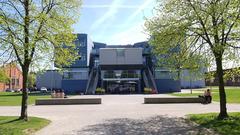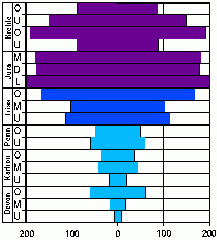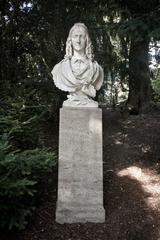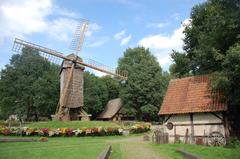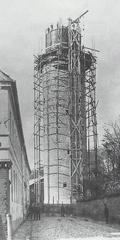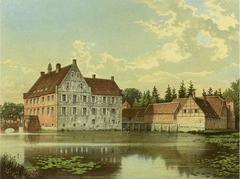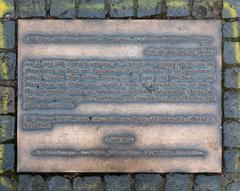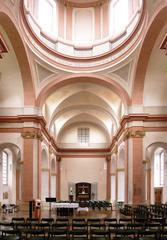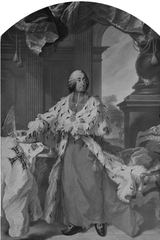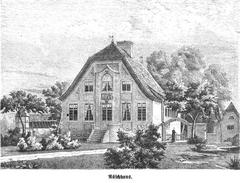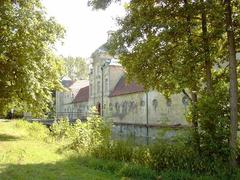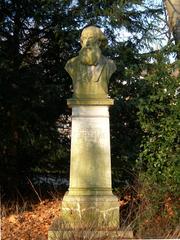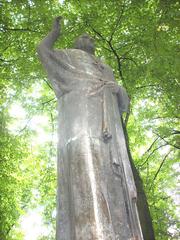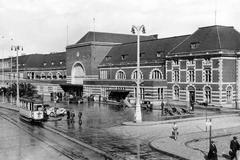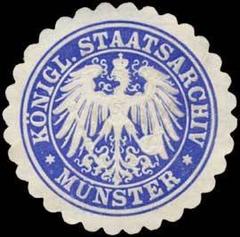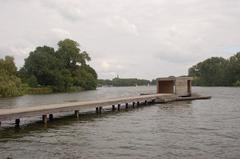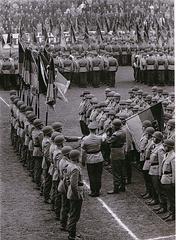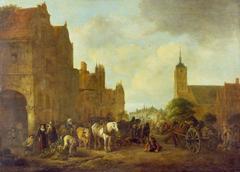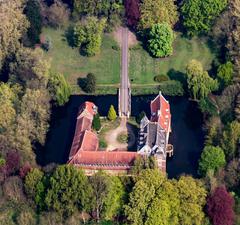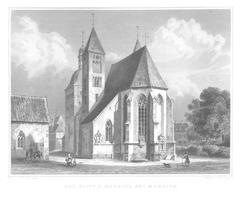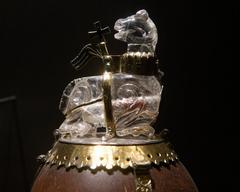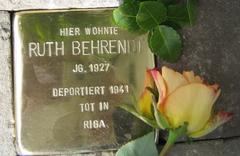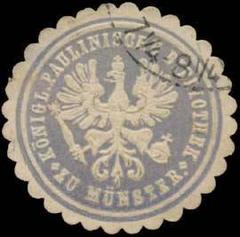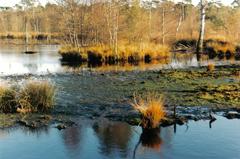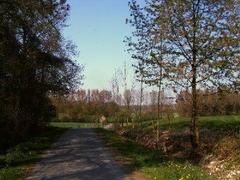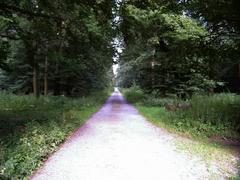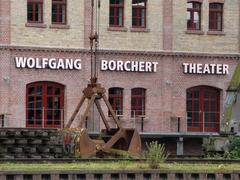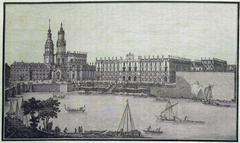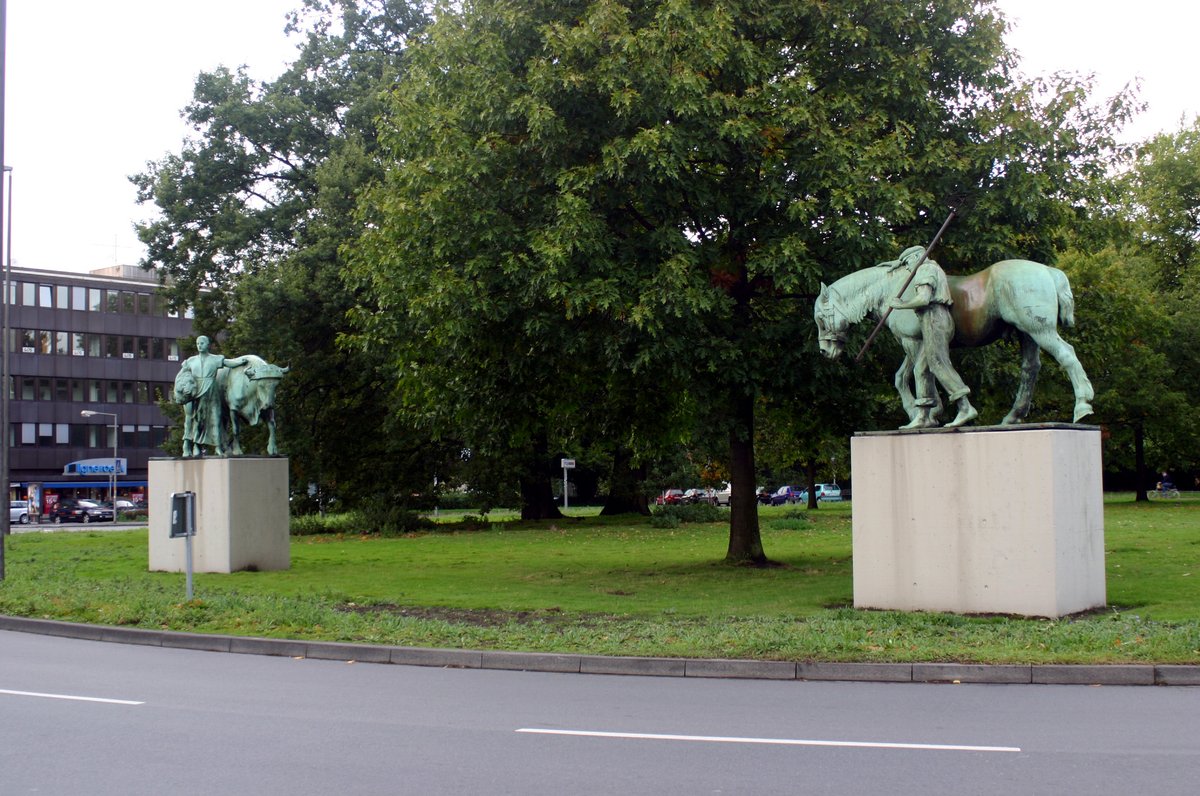
Comprehensive Guide to Visiting Magd mit Stier, Münster, Germany
Date: 24/07/2024
Introduction
Münster, Germany, is a city deeply embedded in history and rich in cultural heritage. One of its most iconic landmarks is the ‘Magd mit Stier’ (Maid with Bull) sculpture, a testament to the city’s agrarian roots and artistic legacy. Created in 1912 by Carl Hans Bernewitz, this sculpture, along with its counterpart ‘Knecht mit Pferd’ (Farmhand with Horse), was designed to honor the rural community that played a significant role in shaping Münster’s identity (source). Over the years, the sculpture has undergone various relocations and restorations, reflecting changing attitudes towards public art and historical preservation. This guide aims to provide comprehensive information for visitors, covering the historical background, visiting hours, ticket details, and nearby attractions. Whether you are a history enthusiast, an art lover, or a casual tourist, the ‘Magd mit Stier’ offers a unique glimpse into Münster’s past and its ongoing commitment to cultural heritage.
Table of Contents
- Introduction
- Historical Background
- Visitor Information
- Historical Context of Münster
- Architectural and Artistic Heritage
- The Anabaptist Rebellion
- Modern-Day Münster
- Visitor Tips
- FAQ
- Conclusion
Historical Background
Origins and Early History
The ‘Magd mit Stier’ (Maid with Bull) is part of a significant sculptural group in Münster, Germany, which also includes the ‘Knecht mit Pferd’ (Farmhand with Horse). These sculptures were created in 1912 and originally positioned as a welcoming gesture to the rural population entering the city. The sculptures were strategically placed on the main road leading into Münster, symbolizing the city’s agricultural roots and its connection to the surrounding countryside (source).
Relocation and Rediscovery
In the 1960s, the sculptures were deemed outdated and were removed from their original pedestals. They were relocated to a less prominent location in front of the Stadthaus, where they remained largely unnoticed and neglected. This period of obscurity lasted until 1986, when artist Rémy Zaugg visited Münster for the Skulptur Projekte and highlighted the paradox of commissioning new sculptures while existing ones were left to deteriorate (source).
Cultural Significance
The ‘Magd mit Stier’ and its companion piece are more than just artistic representations; they are cultural artifacts that reflect the historical and social context of Münster. The sculptures serve as a reminder of the city’s agricultural heritage and its evolution over the years. They also highlight the changing attitudes towards public art and its role in urban spaces.
Restoration and Current Status
Efforts to restore and reposition the sculptures began in the late 20th century, driven by a renewed interest in preserving historical monuments. Today, the ‘Magd mit Stier’ stands as a testament to Münster’s commitment to honoring its past while integrating it into the modern urban landscape. The sculptures have been restored to their former glory and are now prominently displayed, attracting both locals and tourists alike (source).
Visitor Information
Visiting Hours and Tickets
- Visiting Hours: The ‘Magd mit Stier’ sculpture is accessible to the public 24/7. There are no specific visiting hours as it is an outdoor installation.
- Tickets: There is no entrance fee to view the ‘Magd mit Stier’ as it is located in a public space.
Location and Directions
- Location: The ‘Magd mit Stier’ sculpture is located at Ludgeriplatz, Münster 48153, Germany. Coordinates: 51°57’20.003” N 7°37’34.893” E (source).
- Transportation: Münster is well-connected by public transport, and the city is also very bike-friendly, making it easy to explore on two wheels.
Nearby Attractions
- Münster Cathedral (St. Paulus Dom): A prime example of Gothic architecture dating back to the 13th century.
- Prinzipalmarkt: An ancient market street lined with historic townhouses from the Middle Ages and the Renaissance.
- Picasso Museum: Houses an extensive collection of works by Pablo Picasso and other renowned artists.
- Freilichtmuseum Mühlenhof: An open-air museum offering a hands-on experience of German history and culture.
Historical Context of Münster
Münster itself is a city rich in history, dating back to its founding in 793 by Charlemagne. The city was established as a missionary base to convert the Saxons and has since played a significant role in various historical events. One of the most notable events is the signing of the Peace of Westphalia in 1648, which ended the Thirty Years’ War and the Eighty Years’ War, laying the foundation for modern Europe (source).
Architectural and Artistic Heritage
Münster is home to several architectural and artistic landmarks that provide a deeper understanding of its historical and cultural evolution. The Münster Cathedral, also known as St. Paulus Dom, is a prime example. This cathedral has undergone multiple reconstructions since its initial establishment in 805, with the current Gothic structure dating back to the 13th century (source).
Another significant site is the Prinzipalmarkt, the ancient market street lined with historic townhouses from the Middle Ages and the Renaissance. This area was a bustling trading center during the Hanseatic times and continues to be a vibrant part of the city, hosting various festivals and activities throughout the year (source).
The Anabaptist Rebellion
One of the darker chapters in Münster’s history is the Anabaptist Rebellion of the 16th century. Following a lengthy siege, the city fell to Bishop Franz von Waldeck in 1535. The leaders of the rebellion were executed, and their bodies were displayed in iron cages on the tower of St. Lambert’s Church as a grim warning to others. These cages remain a haunting reminder of the city’s tumultuous past (source).
Modern-Day Münster
Today, Münster is a thriving university town known for its eco-friendly bike culture and vibrant nightlife. The city seamlessly blends its rich historical heritage with modern amenities, making it an attractive destination for tourists. Key attractions include the Picasso Museum, which houses an extensive collection of works by Pablo Picasso and other renowned artists, and the Freilichtmuseum Mühlenhof, an open-air museum that offers a hands-on experience of German history and culture (source).
Visitor Tips
For those planning to visit the ‘Magd mit Stier’ and other historical sites in Münster, here are some practical tips:
- Best Time to Visit: Münster is beautiful year-round, but the best time to visit is during the spring and summer months when the weather is pleasant, and outdoor activities are in full swing (source).
- Accommodation: There are various accommodation options ranging from budget hostels to luxury hotels, catering to different preferences and budgets.
FAQ
Q: Are there guided tours available for the ‘Magd mit Stier’ sculpture? A: While there are no specific guided tours for the ‘Magd mit Stier,’ there are general city tours that include this sculpture as part of the itinerary.
Q: Can I take photographs of the ‘Magd mit Stier’? A: Yes, photography is allowed. It’s a popular spot for both amateur and professional photographers.
Q: How do I get to Münster from the nearest airport? A: The nearest airport is Münster Osnabrück International Airport (FMO). From there, you can take a bus, taxi, or rent a car to reach the city center.
Conclusion
The ‘Magd mit Stier’ is not merely a sculpture; it is a cultural artifact that encapsulates the historical and social essence of Münster. Its journey from a welcoming symbol for rural populations to a neglected piece and finally to a restored monument mirrors the city’s evolving identity and its dedication to preserving historical landmarks. Today, the ‘Magd mit Stier’ stands proudly in Münster, inviting both locals and tourists to connect with the city’s rich past. Visitors can explore this and other historical sites, such as the Münster Cathedral and Prinzipalmarkt, to gain a comprehensive understanding of Münster’s cultural and architectural heritage. By planning a visit to this iconic sculpture, you are not only appreciating an artistic masterpiece but also participating in the ongoing narrative of a city that beautifully blends its historical roots with modern vibrancy. For more information and updates, consider downloading the Audiala mobile app or following us on social media.

